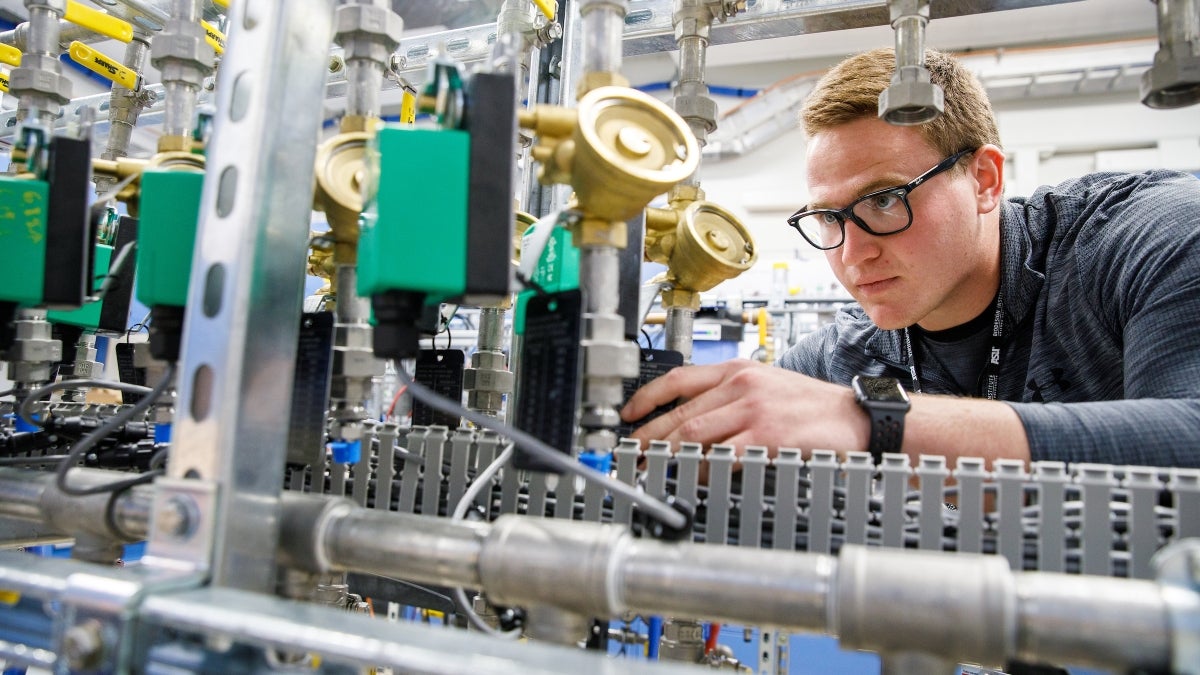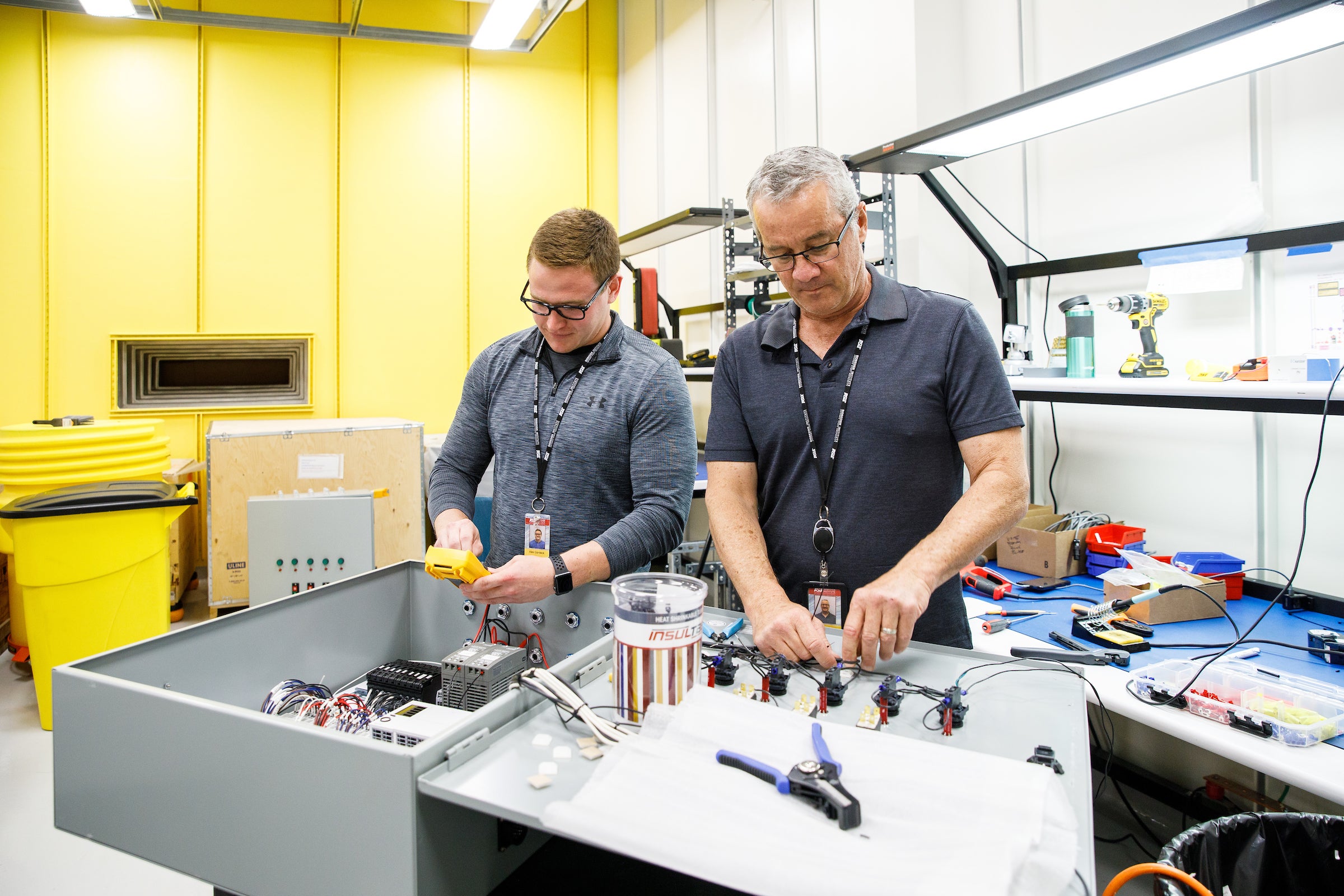What’s better than spending a hot Arizona summer working in a cool basement? Spending a hot Arizona summer in a cool basement, building a scientific instrument expected to be the first of its kind in the world.
Beneath Biodesign Institute building C, five Arizona State University students put their education to work this summer, aiding in the first phase of the compact X-ray free electron laser (CXFEL), a miniaturized high-fidelity X-ray source.
While most free electron lasers are miles long and cost billions to construct, ASU’s CXFEL fits neatly in a traditional lab space at a fraction of its peers’ massive cost. Housed in the Beus Compact X-ray Free Electron Laser Laboratory, the instrument will accelerate electron bunches to nearly the speed of light through a series of three linear accelerators. Powerful magnets will focus and direct the electrons to collide with focused infrared laser pulses. This collision — which generates the power of 100 Hoover Dams, but for only one-millionth of one-millionth of a second — produces X-ray pulses.
This elaborate process will enable scientists to peer into atomic- and molecular-scale structures with unmatched clarity. The CXFEL holds promise to advance discoveries in drug development, medical imaging, materials science, quantum materials and sustainable energy.
The project’s first phase, the compact X-ray light source, is taking shape under the direction of ASU Regents Professor Petra Fromme and Associate Professor Bill Graves, as well as their team in the Biodesign Center for Applied Structural Discovery.
The undergraduate students’ internship was made possible by a $50,000 donation from local philanthropists Bill and Susan Levine to advance the ASU CXFEL. Bill Levine is an investor, real estate developer and founder of Outdoor Systems, an advertising firm. Susan Levine is the director emeritus of Hospice of the Valley and previously served 23 years as the organization’s executive director before retiring in 2016.
“The Levines’ gift created this fantastic opportunity for the undergrads,” said Mark Holl, deputy director of the CXFEL project, who is overseeing the assembly of the instrument and led the student team. “Emphatically, I could not be happier with this team.”
The team’s primary focus over the summer was the physics modeling, design, assembly and testing of the precision thermal control water systems that are used to control the temperature of different CXFEL components. An integral part of the instrument, these systems demand an incredible level of precise water temperature control. One of the three systems requires control within one-hundredth of a degree Celsius, says Holl, who also serves as the chief engineer on the CXFEL.
Mechanical engineering student Alex Gardeck and engineer Steve Rednour work on an electrical control panel of the compact X-ray free electron laser. The students worked alongside the engineering team to bring the first phase of the instrument online. Photo by Andy DeLisle/ASU
The students were smoothly integrated into the team, assembling this system and other instrument components. The work provided them the opportunity to employ their coursework in a professional setting.
“It's been an incredible experience working on this project, because it's been a direct application of everything that I've learned in my undergraduate career,” said Alex Gardeck, a mechanical engineering student in the Ira A. Fulton Schools of Engineering. “Really, we’re just living the everyday life of engineers, encountering problems and figuring out creative ways to solve them.”
Gardeck’s responsibilities included assembling and testing components for the instrument, some of which he 3D modeled using SolidWorks, a computer-aided design and engineering program.
“Hands-on assembly experience will help my designs in the future. When I'm doing a 3D model, everything lines up perfectly, but until I'm starting to torque these wrenches I don’t always see the reality of it,” he said while working on the instrument’s cooling system.
The project also provided students with an opportunity to learn from fellow interns.
Engineering students Brett Liebich and Brandon Cook, who work as electromechanical research technicians at the center, brought a wealth of experience they were able to pass along to the rest of the team. Veterans of the U.S. Navy, Liebich and Cook had previously served on nuclear submarines as a machinist’s mate and electrician's mate, respectively.
“After a decade in the Navy, we were able to get a skill set that you really don't see in a lot of interns or college students,” said Liebich. “Working with some guys who haven't done any of this, we get to not only mentor them a little bit, but also learn from the project engineers. We're engineering students, so the more eyes we can get looking at different things that we might end up doing, it's all good experience.”
While moving from working on nuclear submarines to constructing complex scientific instrumentation isn’t exactly a one-to-one transition, the former sailors nevertheless found similarities between the two jobs.
“The attention to detail, procedural compliance and problem solving that we learned in the nuke program is just being applied in a different fashion here,” said Cook.
Students Alex Gardeck and Brandon Cook examine the precision thermal control water systems that regulate the temperature of components in the radiography/fluoroscopy room of the Beus Compact X-ray Free Electron Laser Laboratory. Photo by Andy DeLisle/ASU
Physics students Dakota King and Albert Wang also spent their summer working on the CXFEL.
“This opportunity is rewarding because it's really hands-on and applied,” said King, who graduated in spring 2019 with his bachelor’s degree. “Physics is a lot of theory. It's cool getting into the engineering side of things.”
“When we’re taught about an instrument or experiment in class, it’s easy to understand why we’re talking about it or the outcomes that made it important,” said Wang, who had previously worked with CXFEL Science Director Graves. “With the CXFEL, it’s almost surreal to work on something that is on the forefront of science. We’re on the precipice of so many possibilities, and while it’s a challenging project, it’s a great opportunity for growth.”
Gardeck, King and Wang were instrumental in the developing both 3D and mathematical physics models of the precision thermal trim unit water systems, according to Holl.
“Initially, we only had a control resolution on the order of one-fourth of a degree Celsius,” said Holl. This was a far cry from the one-hundredth required from the system.
Following the team’s modeling work, they were able to identify the right water flow regulating valves and actuators needed to achieve the precise temperature requirement.
“The students completed the full engineering process, from specifications to modeling the system physics incorporating the properties of real components,” said Holl. “This is a perfect example of an integrated project team with engineering and physics skills brought to bear on a challenging problem. That integration allowed us to achieve a critical need for this accelerator.”
Four of five of the students have remained working on the instrument through the fall semester, contributing as their academic schedules allow. Gardeck, who expects to graduate in the spring, is basing his honor’s thesis on the thermal trim water system.
“I’ve been obsessed with accelerators since I was a kid and I first learned of the Large Hadron Collider,” says Gardeck. “So to be able to work on the CXFEL is a dream come true, and I’m extremely grateful to the Levines for the opportunity.”
The Biodesign Institute is partially supported by Arizona’s Technology and Research Initiative Fund. TRIF investment has enabled hands-on training for tens of thousands of students across Arizona’s universities, thousands of scientific discoveries and patented technologies, and hundreds of new startup companies. Publicly supported through voter approval, TRIF is an essential resource for growing Arizona’s economy and providing opportunities for Arizona residents to work, learn and thrive.
Top photo: Alex Gardeck, a mechanical engineering student, examines one of the precision thermal trim unit water systems that is used to control the temperature of various components of the compact X-ray free electron laser, or CXFEL. Photo by Andy DeLisle/ASU
More Science and technology

4 ASU researchers named senior members of the National Academy of Inventors
The National Academy of Inventors recently named four Arizona State University researchers as senior members to the prestigious organization.Professor Qiang Chen and associate professors Matthew…

Transforming Arizona’s highways for a smoother drive
Imagine you’re driving down a smooth stretch of road. Your tires have firm traction. There are no potholes you need to swerve to avoid. Your suspension feels responsive. You’re relaxed and focused on…

The Sun Devil who revolutionized kitty litter
If you have a cat, there’s a good chance you’re benefiting from the work of an Arizona State University alumna. In honor of Women's History Month, we're sharing her story.A pioneering chemist…




